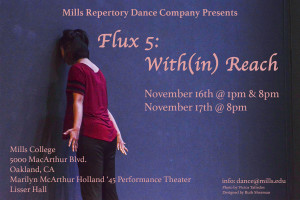
Northern California wildfires late last month.
The Repertory Dance Company’s first performance of “Flux 5: With(in) Reach” was held at Lisser Hall on Dec. 5.
The dance performances were choreographed by international guest artist Victor Talledos and dance department professor Philip Agyapong, along with faculty members Abby Crain and Kara Davis.
The first performance, entitled “Understory/Where Did You Go?” was choreographed by Crain and features original music by musician Timothy Russell. Davis, in an opening statement to the audience before the show, said that Crain’s piece “constructs and deconstructs a haunting dreamscape of emotion, memory, absurdity and the collective unconscious.”
Crain said in the Q&A right after the show that she had been given the start of this piece from Mills dance adjunct professor and department head Sheldon Smith, who had to step out due to an injury. She was inspired by a text, “The Glossary of Haunting,” and grew her piece from there. She said she was inspired by the idea that haunting is used as a reminder to deal with things that may have been forgotten.
“Working with that, it became more about a haunting within one’s self, so we worked with dreams,” she said. “We worked with allowing things to move through us that maybe were not always that inviting to the table.”
Russell’s musical accompaniment echoes the visceral experience of dreams and memories with a challenge to a linear performance format, cycling words and phrases against the dancers’ movements.
“When we’re thinking about memory and we’re thinking about the thought process and how it might exist in a dream, we have these words that come in an out and form a dialogue with itself by trying to recreate that,” he said.
The second performance by Agyapong, who is from Ghana, “Ɛhyɛn Mu,” translates to “in the ship,” displays his thematic and visual inspirations from works such as “Barracoon: The Story of the Last Black Cargo“ by Zora Neale Hurston and “Things Fall Apart” by Chinua Achebe. He describes his piece as an exploration of the minds of Africans who were captured during the transatlantic slave trade and the complex feelings and challenges they experienced.
Agyapong shared his struggle in choosing theater or dance in college and how that influenced the piece.
“I felt that in dance I could actually investigate more of my culture and the dances,” he said. “There, I could make more inquiries in those dances that boils down to the people themselves and how they feel, how they think, how they embrace people.”
When asked what some of the challenges of the process were, Agyapong noted the difficulties of dancers who were less familiar with traditional African dance movement.
“I told them, ‘Just look at African sculpture or African traditional dance movement that you’ve seen before, and pick a movement to create from there,'” he said in the Q&A. “So I told them no toe pointing, no linear movement.”
He said he was very aware of the fact that not all of the dancers casted were Black and used the diversity in the cast to represent the diverse ethnic groups in Ghana, as one dancer spoke in Spanish during the piece. He wanted to explore this from an artistic point of view and let them be themselves rather than just teaching them the local language.
The third performance of the night was “Rebirth Within” from Victor Talledos, an artist from Mexico and based in San Francisco. His piece celebrated “feminine power and the audacity of perseverance in the wake of sustained oppression,” Davis said in the introduction. Having grown up surrounded by women his entire life, he was inspired by women’s empowerment as evidenced in the annual Women’s March.
He explored the concept of power in his piece, but the core material comes from the dancers’ stories and lives.
“I was very curious about their own stories,” he said of the five female dancers. Through open conversation about their lives, Talledos and his dancers were able to create a bold exploration of power and how it relates to gender. “I just feel that [myself and the dancers] complement each other and we need to be part of the conversation,” he said.
The last performance was Kara Davis’s “Strata.” She described it as an experience of “how we mine our emotional landscape for wisdom.”
She used the Grand Canyon as a geographical metaphor of something being built from the top down to represent the human experience and things that happen that shapes us from the inside and how we see the world on the outside, she said.
“A lot of material was generated by the dancers,” she said. “Seeing them and what had made an impact on them or affected them in a profound way that had shaped their way of seeing themselves in their worlds.”
Davis underscored the relationship of decay to our inner selves and how that shaped the performance. When asked what she wanted the audience to take away from the piece, she said, “Destruction and renewal and that all of us are made beautiful in our state of decay.”
The dancers themselves are dedicated and passionate in their roles, which clearly is reflected in “Flux 5.” Kenya Hilliard, a second year MFA student and dancer in Talledos’ piece, shared her thoughts about what she wanted to convey to the audience, something that “Flux 5” brilliantly achieved.
“I like the audience to have some sort of emotion, whether it’s good or bad or anything,” she said. “As long as they’re feeling something, I know I’ve done my job, because they’re not just passively watching a performance.”
